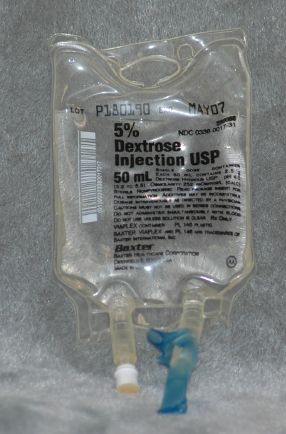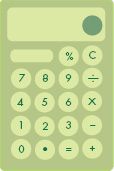TERMS
•Drop factor (tubing volume)
•Infusion rate table
•Intravenous
•Intravenous piggyback
OBJECTIVES
Upon completion of this chapter, the technician student will be able to:
•Identify components of common intravenous solutions.
•Calculate the quantity of specific components of common intravenous solutions.
•Calculate flow rates in drops per minute and milliliters per hour using formulas.
•Calculate infusion times and completion times.
•Calculate flow rates for critical care patients per minute and per kilogram per minute.
IV (intravenous) fluids are ordered for a variety of reasons in addition to giving medications. Replacement IV fluids are ordered when fluids have been lost to vomiting, diarrhea, or hemorrhage. Maintenance IV fluids are ordered to sustain normal fluid and electrolyte balance. This chapter concentrates on the calculations involved in administering these fluids and other IV medications. Regulation of IV fluids is normally not a pharmacy technician duty. This chapter introduces these calculations to the student technician. Figure 13.1 shows an IV fluid and its administration set.

Figure 13.1IV fluid and an administration set.
IV Abbreviation for intravenous; may refer to medication or fluid infused into a vein over time.
Intravenous fluids may be administered either continuously or intermittently, in large volumes and small volumes. The small volumes most often contain an additive and are usually piggybacked into the line the large fluid runs in. Many IVPB (IV piggyback) medications once mixed by the pharmacy technician now come prepared from the manufacturer in systems like the ADD-Vantage system by Abbott laboratories (Fig. 13.2). The pharmacy technician will probably have ample practice mixing IV additives in the aseptic products course.

Figure 13.2The ADD-Vantage system by Abbott Laboratories.
IVPB Abbreviation for intravenous piggyback, a secondary line attached to a primary IV line to infuse medication (e.g., an antibiotic) on an intermittent basis.
IV lines are placed either in a peripheral site (arm, hand, or sometimes leg or foot) or centrally (in a large vein, such as the subclavian). Where the line is placed depends largely on how long the patient is expected to receive IV medications.
The pharmacy staff may be responsible for helping the medical staff determine the flow rate or calculate the volume to be administered over a specified time. Intravenous flow rates are calculated in milliliters per hour when the fluid is administered by an infusion pump. Manually regulated or gravity flow IV mixtures are calibrated in drops (gtt) per minute using tubing regulated to deliver a standard drop per milliliter.
 Common IV Solutions
Common IV Solutions
Dextrose, water, sodium chloride, and certain electrolytes and salts are common components of IV fluids. Dextrose (Fig. 13.3) and sodium chloride are the most common solute components of IV fluids. Table 13.1 lists the common fluids and their components and abbreviations.

Figure 13.3Dextrose is one of the most common solute components of IV fluids.
The amount of the solute in these common IV fluids follows the rules set out in Chapter 9 of this text (see percent weight-in-volume in Chapter 9 or in the glossary). For example, NS is 0.9% sodium chloride; it contains 0.9 g of sodium chloride in 100 mL of fluid.
Review Set 13.1: Common IV Solutions
Calculate the amount of solute (in grams) of the following IV fluids.
1.1 L of D5W
2.1 L of NS
3.2 L of 5% dextrose 1/2 NS
4.1 L of D10W
5.1 L of D5 0.33% NaCl
 Rate of Flow of Intravenous Fluids
Rate of Flow of Intravenous Fluids
Large-volume parenterals for continuous IV administration are hung at the patient’s bedside and allowed to drip slowly into a vein by gravity flow or through the use of electrical or battery-operated volumetric infusion pumps. Some of these pumps can be calibrated to deliver microinfusion volumes (e.g., 0.1 mL per hour) to as much as 2000 mL per hour, depending on the drug and the needs of the patient. Solutions of additive drug may be placed directly in the large-volume bag. Sometimes, however, they are kept in a small-volume bag (minibag) that is hung piggyback; in this case the drug enters the tubing of the primary bottle of IV fluid at a controlled rate. In either case, the physician specifies the rate of flow of IV fluids in milliliters per minute, drops per minute, amount of drug (as milligrams per hour), or more frequently, as the approximate duration of administration of the total volume of the infusion. When an infusion pump is used, the rate is always expressed in milliliters per hour and is always a whole number, so decimals are rounded up. The pharmacist may be requested to make or to check the calculations for converting the desired total time into a flow rate of drops per minute.
Rules for IV Flow Rates

•Flow rates are always whole numbers.
•Infusion pumps are always milliliters per hour.
•Manually regulated or gravity flow infusions are drops per minute.
Large-Volume Intravenous Fluid Delivery over Specified Period
Calculating the rate of flow to administer a large-volume IV fluid during a desired time interval entails the following:
Examples:
A physician has ordered 1 L of D5W to infuse over 8 hours by infusion pump. Calculate the flow rate.

The order is 1500 mL of D5 1/2 NS to infuse over 24 hours by infusion pump. Calculate the flow rate.
![]()
A physician has ordered 200 mL of an antibiotic to be infused over 2 hours by an infusion pump. Calculate the flow rate.
![]()
The order is 50 mL of an antibiotic to infuse over 30 minutes by an infusion pump. Calculate the flow rate.
![]()
Review Set 13.2: Rate of Flow of Intravenous Fluids
Calculate the flow rates of the following IVs, all infused by electronic infusion pump.
1.2 L of D5W over 24 hours.
2.1800 mL of NS over 10 hours.
3.An antibiotic in 50 mL of fluid to run over 30 minutes.
4.100 mL of an antibiotic in NS to run over 30 minutes.
5.1.5 L of NS to run over 24 hours.
Manually Regulated IV Flow Rates
When an electronic infusion pump is not used, the IV solution is manually regulated with tubing that is calibrated to deliver a standard number of drops per milliliter. This is known as the drop factor. Tubing is available in a variety of sets, each with its own drop factor, ranging from the macro sets, which deliver 10, 15, or 20 gtt/mL, to the microdrip or minidrip sets, which deliver 60 gtt/mL.
drop factor Manual regulation of an IV solution with tubing that is calibrated to deliver a standard number of drops per milliliter.
The flow rate for a manually regulated IV is expressed in drops per minute. This rate, like the infusion pump, is always expressed as a whole number. The following formula is used:
![]()
This formula not only can be used to determine the flow rate but is also useful in determining volumes and infusion times.
Example:
A medication order calls for 1000 mL of D5W to be administered over 8 hours. With an IV set that delivers 10 gtt/mL, how many drops per minute should be delivered to the patient?
Volume of fluid = 1000 mL
Time of infusion 8 hours = 480 minutes
![]()
Solve by Dimensional Analysis
![]()
The order is 1500 mL of an IV fluid to be infused over 12 hours, using an IV administration set that delivers 15 gtt/mL. What is the flow rate in drops per minute?
Time of infusion: 12 hours = 720 minutes
![]()
The pharmaceutical technician has mixed 10 mL of 10% calcium gluconate injection and 10 mL of multivitamin infusion with 500 mL of a 5% dextrose injection. The infusion is to be administered over 5 hours. If the dropper in the venoclysis set calibrates 15 gtt/mL, at what rate in drops per minute should the flow be adjusted to administer the infusion over the desired time?
Total volume of infusion = 10 mL + 10 mL + 500 mL = 520 mL
Dropper calibrates 15 gtt/mL.
Time of infusion: 5 hours = 300 minutes.
![]()
Solve by Dimensional Analysis
![]()
Review Set 13.3: Manually Regulated IV Flow Rates
Calculate the flow rates of the following IV fluids in drops per minute.
1.1 L of NS to run over 8 hours using tubing calibrated to deliver 10 gtt/mL.
2.1 L of D5W 0.33%NS to run over 6 hours. The drop factor is 15 gtt/mL.
3.3 L of D5W to run over 24 hours. The drop factor is 10 gtt/mL.
4.60 mL of an IVPB to run over half an hour with tubing calibrated to deliver 60 gtt/mL.
5.250 mL of fluid to run over 90 minutes with a tubing set to deliver 60 gtt/mL.
6.3 L of D5W ordered to run at 125 mL/hour with tubing delivering 10 gtt/mL.
7.D5 ½ NS ordered to run at 25 mL/hour with a drop factor of 60 gtt/mL.
8.50 mL of an antibiotic to run over 30 min with tubing calibrated to deliver 60 gtt/mL.
9.D5W running at 200 mL/hour with a drop factor of 10 gtt/mL.
10.3 L of NS to run at 125 mL/hour with a tubing set that delivers 15 gtt/mL.




